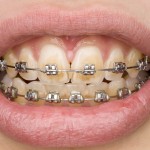
This review aims to assess the role of the various characteristics of orthodontic brackets (material, slot size, ligation type, etc) and their combination with specific wires on their clinical effectiveness and associated side-effects during fixed-appliance orthodontic treatment.
Searches were conducted in Medline, Cochrane Library, Biomed Central, BBO including LILACS, Ind Med, Sceilo, Clinical trials.gov, Conference paper Index, Digital Dissertations, German National Library of Medicine (ZB MED), Google Scholar, ISI Web of Knowledge, metaRegister of Controlled Trials, OpenSIGLE, Scirus. Randomized controlled trials (RCTs) and quasi-RCTs in patients having fixed-appliance orthodontic treatments were considered.
- 25 trials involving 1321 patients were included. Two reviewers carried out study selection, data extraction and Cochrane risk of bias assessment independently.
- No trial primarily investigated the effect of bracket material and no indirect comparison was possible.
- The bracket slot size was assessed in 2 trials, which found no consistent difference between 0.022” and 0.018” brackets
- The vast majority of trials (24) compared self-ligated (SL) and conventional brackets (CL)
- 4 studies contributed to a meta-analysis that showed overall duration of the orthodontic treatment be significantly longer in the SL group by 2.01 months (95%CI; 0.45 to 3.57)
The authors concluded
Based on existing evidence, no clinical recommendation can be made regarding the bracket material or different ligation modules. For SL brackets, no conclusive benefits could be proven, while their use was associated with longer treatment durations.
Comment
This interesting review has been conducted using sound methodology and provides very extensive information both in the main article and in the supplemental material provided. A large number of parameters have been considered but many of them could only be compared in a small number of studies. As the authors note in order to make definitive recommendations about the materials, size, and ligation of orthodontic brackets more high quality RCTs are needed. A recent trial by Songra et al on self ligating brackets has been published in the American Journal of Orthodontics and Dentofacial Orthopedics and is the subject of a blog by Kevin O’Brien.
Links
Papageorgiou SN, Konstantinidis I, Papadopoulou K, Jäger A, Bourauel C. Clinical effects of pre-adjusted edgewise orthodontic brackets: a systematic review and meta-analysis. Eur J Orthod. 2013 Oct 1. [Epub ahead of print] PubMed PMID: 24062378.
Kevin O’Brien’s Orthodontic Blog – Self Ligation: Another nail in the coffin?
Songra G, Clover M, Atack NE, Ewings P, Sherriff M, Sandy JR, Ireland AJ. Comparative assessment of alignment efficiency and space closure of active and passive self-ligating vs conventional appliances in adolescents: A single-center randomized controlled trial. Am J Orthod Dentofacial Orthop. 2014 May;145(5):569-78. doi: 10.1016/j.ajodo.2013.12.024. PubMed PMID: 24785921.

[…] Dental Elf – 23rd May 2014 – Review finds that orthodontic treatment using self-ligated brac… […]